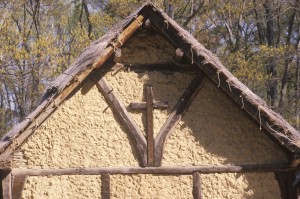The Secret Catholics of Jamestown
 Church in Jamestown Settlement, a living history museum near the original settlement site.
Church in Jamestown Settlement, a living history museum near the original settlement site. In 2010, archeologists from Preservation Virginia discovered four post holes on the Jamestown Settlement (the first successful colonial settlement in the US) which were the remains of what they believe to be the earliest church of Jamestown, Virginia. As fascinating as the discovery was, it would lead the team to an even greater finding that could change what we know about religion in America’s first days.
Four graves were found at the site of the church, one of which held the remains of a particularly prominent figure of the original Jamestown settlement community. Captain Gabriel Archer, a man of high military rank and a recognized settler of Jamestown, had died around 1609, and because of his high status, he was buried near the altar of the church in a large white-oak coffin in the shape of a hexagon, curiously placed with his head to the east, a position reserved exclusively for the clergy. Inside the coffin was a small silver box containing bone fragments and a tiny capsule thought to have held either holy water or blood, both characteristically Catholic.
Why is it so interesting to find a Catholic leader buried at Jamestown? Because this discovery leads to the speculation that some of these early settlements were less mono-religious than we thought.
Although England’s monarchy had previously been Roman Catholic, King Henry VIII pushed out the Catholic Church in 1534 and became the head of both the church and government of England. And despite Henry’s daughter Queen Mary I’s efforts to return England to Catholicism after her father’s death, her successor Elizabeth I established the Church of England and reigned for forty-four years.
The settlers of Jamestown were Anglicans and brought the religion with them to the new world. Though the Virginia Company, who settled Jamestown, was sent to settle in the Chesapeake region for financial purposes unlike the pilgrims entering Plymouth who were motivated by religious freedom, they were not particularly welcoming to Catholics. In fact, they were still quite dedicated to the Church of England.
Yet Archer was buried with artifacts representative of the Catholic faith, which means that the items must have been particularly meaningful to him, and someone burying him knew that. One could conclude that a Catholic leader and artifacts found at a site of the Anglican Church hints at the existence of a secret Catholic community in the earliest stages of the formation of America. This discovery may show the diversity in beliefs that the settlers held. Going back to the questionable placement of Archer’s head to the east—it has been suspected that Jamestown may have been without a cleric at the time of Archer’s death and may have been in the position of leader of the clergy during that time. It is also suspected that, because he was buried with Catholic relics, he himself may have been a secret Catholic priest.
There any numerous possibilities to what this finding could mean. But what it does do is remind us that America is a place that must embrace its religious diversity in accepting both the practice and non-practice of religion, as it was founded by members of varying faiths, regardless of the one designated.
